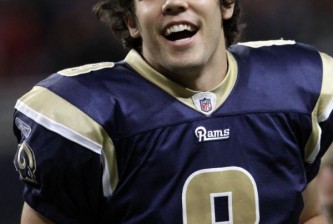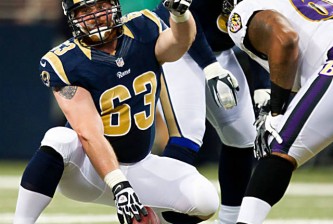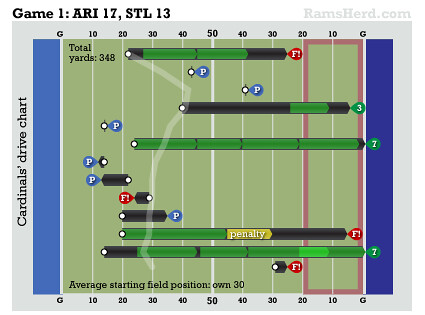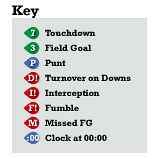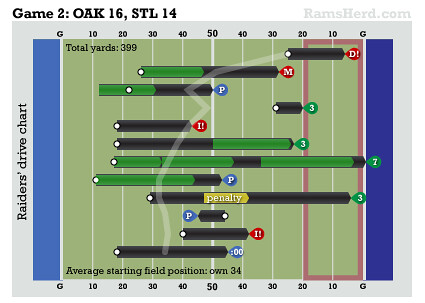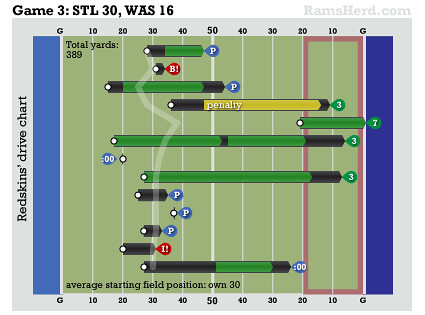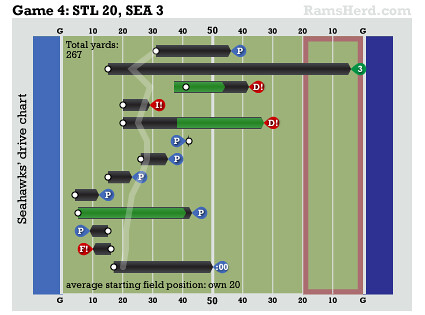After watching the Rams’ domination of the Seahawks, and the way we kept pinning them back in their own end zone as the game went on, I started out this feature expecting to write about “controlling field position” as the secret ingredient. But what I found was something else — rather than field position, it has been the Rams’ increasing ability to prevent big plays that seems more closely correlated with our defense’s ability to keep points off the board. This becomes apparent when you look at the drive charts for each game, showing how each team got their points against us so far this season, with big plays against us highlighted. Cue the infographics!
I’m defining a “big play” as anything that gains 15 yards or more — this gives me an easy reason to include personal foul penalties, like the (weak) Roughing the Passer flag against Dante Hall that contributed to a red zone drive late in the game. And in this season opener against the Cardinals, we made them look like a much better team than perhaps they were, by giving up 12 big plays. Notably, their lone touchdown drive came on four consecutive runs of 15 yards or more. That’s just nuts, and thankfully, hasn’t been repeated yet this season.
The squiggly white line shows the moving average of our opponents’ starting field position. But even though we became more successful in controlling that field position as the game went on, it didn’t help the Rams keep points off the board. (However, you could argue that it helped them limit those points to field goals.)
The Rams fared little better against the Raiders, giving up seven big plays. The quantity was smaller, but again, we see a touchdown drive built on nothing but huge plays — passes to Hey-Bey and Zach Miller, and a 30-yard run by Darren McFadden. And again the Rams shoot themselves in the foot with another roughing the passer call, this one on Atogwe, that contributes to the game-deciding points.
The Redskins’ offense appears to be almost entirely dependent on big plays, and the Rams obliged them by allowing eight of them, including five in their four scoring drives. (The one that really hurt was the 39-yard pass interference penalty on Bradley Fletcher, accounting for all but 14 yards of a scoring drive.) However, once they locked down in the second half, the defense gave the Rams’ offense the chance to recover and take the game over.
Finally, the Rams’ defense plays a complete game, and nearly pitches a shutout. For the first time this season, they avoided a major penalty, and the three big plays they gave up were mostly harmless, or countered by big plays of our own.
The most notable example was Seattle’s double-pass trickeroo for 28 yards… it started on the SEA 39 yard line, and got the ‘Hawks to the furthest fringe of Olindo Mare’s field goal range. A stand by the defense there led to Pete Carroll’s ridiculous decision to double down on trickeration, trying a fake field goal that was blown up by Kevin Dockery. (Dockery, who the Rams just re-signed after cutting him a week earlier, earned his game check on that play .. and a trip to the trainers’ room to close a 13-stitch gash in his head, courtesy of the kicker’s cleat.)
This is a trend that will have to continue if the Rams are going to beat the Lions, a team that despite its record, has playmakers capable of making game-changing plays.




















